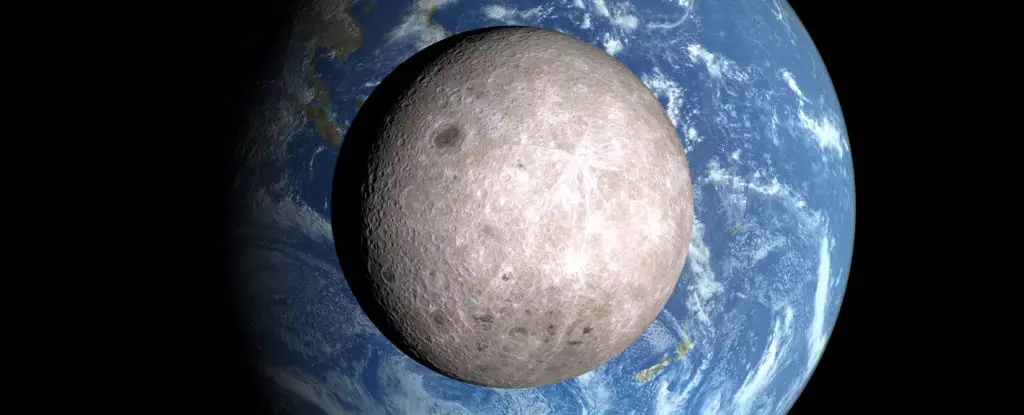Recent studies have shed light on an intriguing aspect of our celestial companion, the Moon: its uneven distribution of water. Contrary to what some might expect, the far side of the Moon, the hemisphere that faces away from Earth, harbors significantly less water than the near side. This finding poses a fascinating riddle in planetary science, as the Moon’s two hemispheres are starkly distinct. The near side showcases expansive basaltic plains, known as maria, formed by ancient volcanic activity. In contrast, the far side is adorned with a chaotic array of craters, hinting at a more tumultuous history. The disparities between these two regions beg the question: how did they develop such divergent natures?
With insights from the Chang’e-6 mission, which successfully returned samples from the far side, researchers have begun to piece together this enigma. The analysis suggests that the lunar mantle’s water content plays a critical role in understanding the Moon’s formation, particularly the leading hypothesis that it emerged from a colossal impact event billions of years ago. This analysis is not just a simple catalog of findings; it challenges our understanding of lunar geology and the processes that have shaped both the Moon and possibly Earth.
The Impact Hypothesis: A Deeper Look
The prevailing theory of lunar formation involves a cataclysmic collision with a Mars-sized body termed ‘Theia.’ During this formative period more than 4.5 billion years ago, debris from the collision became entrapped in Earth’s orbit, eventually coalescing into what we now recognize as the Moon. One striking outcome of this velvety chaos was the emergence of the lava plains on the near side, which testify to a period of significant volcanic activity between 3.9 and 3.1 billion years ago.
Despite the allure of this formation narrative, the role of water in detailing the interior makeup of the Moon cannot be understated. The researchers led by Huicun He and Linxi Li have shown that the water abundance patterns observed across the lunar surface can yield insights into the Moon’s thermal history and volcanic activity. This research is a significant leap forward in refining the giant impact hypothesis, particularly in relation to how this titanic collision affected the distribution of critical elements, such as water.
The Mystery of Lunar Asymmetry
As scientists pore over the data from lunar samples, the asymmetry of water availability between the two sides of the Moon stands out. Past studies revealed a variably water-rich region, with samples from the Procellarum KREEP Terrane on the nearside holding up to 200 micrograms of water per gram of rock, while the far side samples show strikingly lower concentrations—between 1 to 1.5 micrograms per gram. This disparity raises compelling questions about the thermal evolution of the Moon.
One theory posits that the thinner crust on the near side, a legacy of consistent heating from a still-forming Earth, allowed for a robust volcanic outflow, leading to the formation of maria. This uneven cooling suggests that the Moon’s interior may have experienced different thermal paths, resulting in the far side’s water-poor characteristics. Understanding these variations is increasingly crucial for future explorations, particularly when considering the Moon’s potential for supporting human presence and resource utilization.
The Chang’e-6 Contribution
China’s Chang’e-6 mission has provided a golden opportunity to garner first-hand samples from the far side of the Moon. By conducting detailed analyses of the materials retrieved from the South Pole-Aitken Basin—one of the Moon’s largest impact craters—scientists have gleaned vital information about the Moon’s geological history and composition. The mineralogical studies conducted using cutting-edge techniques, such as scanning electron microscopy, have revealed a striking scarcity of water in the basalt found in this area, supporting the theory that the Moon’s formation and subsequent evolution were heavily influenced by a series of impactful events.
Moreover, the Chang’e-6 investigation opens the door to further probing the Moon’s crustal secrets. While this initial data points toward an overall drier far side, the complexity of lunar geology demands continued exploration. There could be regions of higher water content yet to be discovered, hinting at a rich tapestry of geological processes that unfolded in tandem with the Moon’s dramatic history.
Future Implications
As research continues and more lunar samples are collected, the implications of these findings extend beyond academic curiosity. Understanding the Moon’s water distribution is crucial for future exploratory missions aimed at establishing a sustainable human presence. The prospect of utilizing lunar water resources could be a game-changer for long-term space exploration. As we seek to push the boundaries of human presence beyond Earth, comprehending our Moon becomes not just an exercise in scientific inquiry, but a fundamental component of our interplanetary future.


Leave a Reply